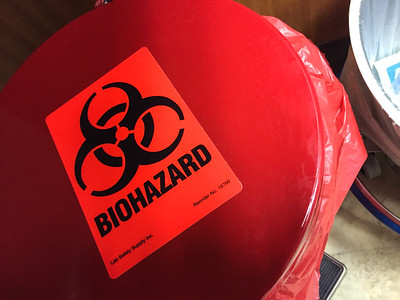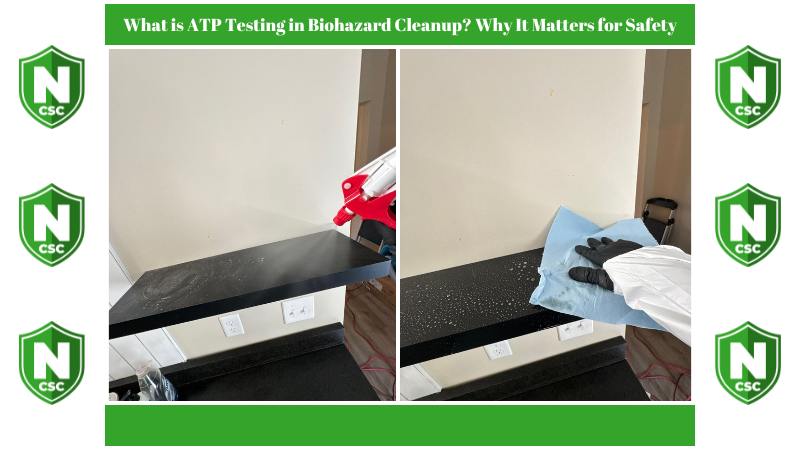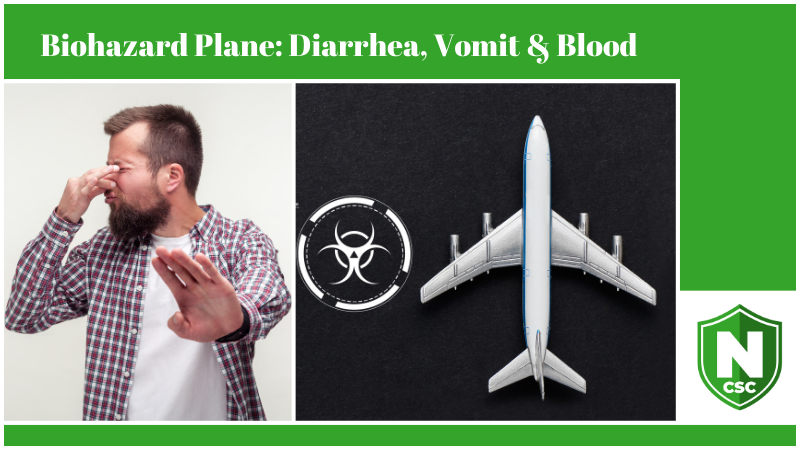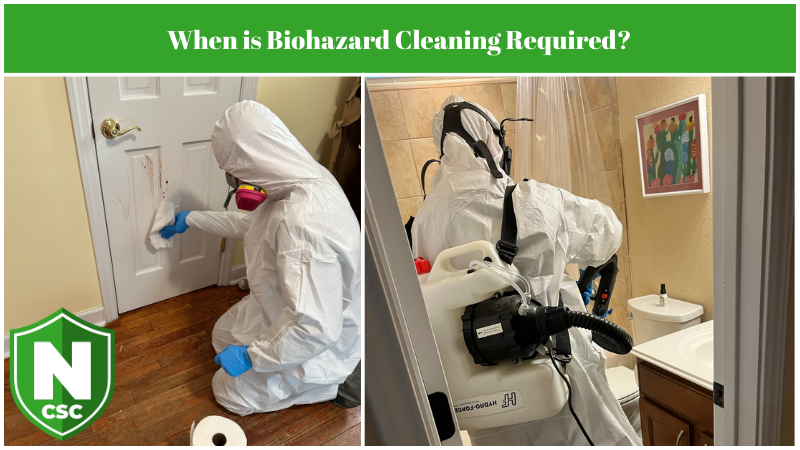Typical Biohazard Damages and Situations

A Biohazard Disposal Container (Courtesy of Tony Webster on Fickr)
Biohazards are known as any biological substances that endanger living organisms. These can be considered animal waste, human waste, and bodily fluids, including blood. They must be living or contain potentially harmful living organisms. Some examples include animal feces, contaminated sharps (e.g. needles, syringes), lab waste (e.g. used petri dishes), or pathological waste (e.g. surgical specimens).
A biohazardous situation occurs whenever there is a biohazard spill or biohazards that require professional remediation. A biohazard spill can be the result of a homicide, suicide, or accidental injury. All of these situations require the intervention of a professional cleaning crew or company and should never be taken care of by untrained staff, families, or individuals.
The National Crime Scene Cleanup (NCSC) is fully licensed by federal, state, and local agencies to professionally remediate, restore, dispose, and transport biohazard waste. In over 20 years of experience, there are many biohazard cleanups that NCSC’s nationwide crews have responded to, including:
- Crime scenes
- An unattended death, workplace accident, or childbirth in a car can cause a spill of various bodily fluids
- Drug labs or overdose situations including meth, fentanyl, heroin, crack, or other controlled substances
- Contaminated ambulances, hotels, and offices
- Hoarding situations involving animals, garbage, or rotting food
All of these types of situations vary in severity, and as such, the PPE and supplies required do as well.
Typical Biohazard Damages at a Crime Scene
A crime scene is literally any type of scene that involves a crime. A typical crime scene may have hundreds of biohazards present, from bodily fluids to human tissues and waste. Most of us are familiar with crime scenes from TV shows and movies, though many are unaware of what happens after. After detectives collect evidence and clear the scene, the property owner is left responsible to take care of the remaining damages. That’s where NCSC intervenes.
Remaining damages after a crime scene can range from small to big, depending on how the murder occurred. Below are two examples of small and big crime scenes.
Minor Damages on the Set of Rust (2021) near Santa Fe, NM
The production of Rust (2021) made headlines when Alec Baldwin fatally shot his cinematographer Halyna Hutchins and wounded assistant director Joel Souza. The FBI ruled the shooting as accidental, although it is still unclear how Baldwin ended up with the loaded gun on the set.
What is certain is that the event became one of the most unforgettable tragedies in film history, and one of the most unforgettable cleanups NCSC has seen. Part of what made the situation unforgettable is that minor crime scene damages like that are very rare.
Major Damages at a Lululemon Athletica in Bethesda, MD
In 2011, the morning manager of a Maryland Lululemon Athletica entered the store to find an extremely bloody and dramatic crime scene. Mannequins were strewn over the store, bloody shoeprints were tracked around the store, and moaning could be heard from the back. The manager discovered Brittany Norwood in the bathroom with scratches and blood on her forehead and the dead body of her co-worker Jayna Murray in the corner of a hallway.
Norwood explained she and her co worker had been attacked by two masked men. The testimony did not hold up in court as investigators discovered self inflicted wounds on Norwood and hundreds of self defense wounds along Murray’s body. Norwood later confessed to the brutal murder of her co worker Murray.
The biohazards for this crime scene were discovered to be blood and bodily fluids dripping down the back hallways (warning: GRAPHIC IMAGE), saturating the floor, and intentionally tracked through the store to stage the scene. This amount of major damage is typical for what NCSC crews ordinarily see.
Other Types of Damages Caused By Bodily Fluids
NCSC crews have responded to bodily fluid spills of all different types. These are circumstances that occur from all different types of incidents–from unattended deaths, workplace accidents, to the birth of a child in a car en route to the hospital.
Bodily fluid spills are a broad category that refers to any potentially infectious materials per OSHA. It can be:
- Saliva, which can carry infectious diseases such as mononucleosis
- Semen or vaginal secretions, which may pass sexually transmitted diseases such as AIDS
- Vomit, feces, and urine, all of which attract harmful pathogens and/or disease
- Amniotic fluid, a clear, translucent yellow fluid released during childbirth
Traumatic injuries, such as those that are exposed in a homicide or gunshot accident, can expose the following bodily fluids:
- Joint (Synovial) fluid, present in knees, wrists, shoulders, and can appear from thin to thick and range from red to yellow when exposed
- Cerebral spinal fluid, a clear watery fluid when exposed.
There are hundreds of other bodily fluids in the body, ranging from brain fluid to heart lining fluid. All fluids in the body are prone to carrying disease or infection, which is why these are considered biohazards that must be specially removed.
How The Damage Happens and Why Situations Vary
It depends on the situation and how the decomposition reacts with the surrounding environment. An unattended death that occurs in a home with no A/C in Florida is going to expose more bodily fluids than an unattended death in Maine during the winter. In general, though, NCSC cleaners reasonably expect a scene riddled with feces, urine, blood, and other leaking bodily fluids. This is because the body evacuates its bowels after death–and as time passes, the body releases even more bodily fluid as is broken down by pathogenic microorganisms. The labor required to treat these situations varies because the longer the body is left unattended or in extreme heat, the more bodily fluids there are to damage the surrounding area and building.
Homicides, gunshot accidents, or workplace accidents present similar situations. Depending on how it happened or what the situation was, blood and biomatter can be saturated in one area or coat the entire room. Homicides or situations involving guns are usually always a mess. There have been homicidal or gun situations that result in minor aftermath, similar to the Baldwin shooting, though we don’t see them often.
Biohazard Damage As Result of a Drug Lab or Overdose
Frighteningly, the amount of drug lethal overdoses in America is rising. There has been a 59% spike in opioid-related fatal overdoses between 2017-2021. Other types of drug-related overdoses have had significant increases as well, from deaths involving psychostimulants like meth rising to 32,537 deaths (a 26% increase over the previous year). It’s thought to be the alarming amount of rising fentanyl use, as well as cases of overdoses that involved fentanyl-laced substances.
Fentanyl is considered the most dangerous drug in the world–it only takes ingesting a very small trace amount to cause a fatal overdose. Drugs like fentanyl and meth need to be handled and neutralized professionally. NCSC has been called to handle drug lab contaminations and overdoses for various situations–from fentanyl to meth.
Contaminations in Ambulances, Hotels, and Offices
Nonvisible biohazards are pathogenic bacteria, viruses, and diseases that cannot be identified by the naked eye. Their potential life-changing effects are the reasons why OSHA has procedures in place for the proper decontamination and disposal of such waste. NCSC crews are trained in the same procedures as hospitals to handle matters involving outbreaks and other contaminations as required through OSHA’s biohazard laws. NCSC has responded to emergencies involving the full decontamination of ambulances, hotels, and offices–to name a few.
Damages Caused By Hoarding Situations
A hoarding situation crosses the line to a biohazard when pathogenic or harmful biological substances encompass a large portion of a home or building. The situation can present additional dangers (e.g. fire hazards) if the mass of items compromises the property’s structure. NCSC crews have seen situations from ceiling-high piles of rotting food to ankle-high piles of animal waste as the result of animal hoarding. Animal waste implies the presence of rodents, roaches, and other bugs–all which cause permanent staining, damage, and odors to the infrastructure of the home.




